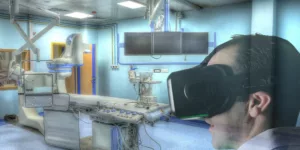Virtual reality is gradually taking over the healthcare system. It has affected both doctors’ work and patients’ lives positively. Initially, many people thought that this technology is just about gaming, but its transformation of medicine is fascinating. Scientists, medical practitioners, and clinical researchers are developing and applying virtual reality to facilitate the training of medical personnel; and the diagnosis and treatment of many medical conditions.
Here are some of the changes in medicine that resulted from virtual reality.
Surgical Training
VR has significantly transformed the teaching and learning process in medicine. Usually, students in an operating room peek over the shoulder of a surgeon to learn the surgery. With VR, medical students use their VR goggles to view an operation as surgeons stream it through VR cameras. This technology allows the students to be present in the operating room using their VR devices. They can learn from the experienced doctors without assisting them during surgery. Also, Stanford University developed a surgery simulator that provides haptic feedback to the students.
Relief for Chronic Patients
App developers have innovated various VR experiences to reduce pain and stress in patients. With VR gear they can visit different virtual environments and participate in the activities there. Medical VR improves the condition of patients and may reduce the cost of healthcare. Virtual reality app development has aided the treatment of many conditions.
‘Farmoo,’ an application created by Henry Lo, eases the pain in cancer patients. This project distracts them during chemotherapy as they concentrate on the game. A video game, SnowWorld, is a VR experience used by doctors to distract burn victims during treatment.
Treatment of Phobias
Psychiatrists are using exposure therapy to treat patients with fears. The patients are allowed to face their fears in a controlled virtual reality environment. Being in an immersive surrounding with the phobia such as flying objects will enable a patient to learn coping strategies.
Treatment for PTSD
Just like the management of anxieties and phobias with exposure therapy, virtual reality is used to treat soldiers who have post-traumatic stress disorder (PTSD). VR simulations of warfare are used in a controlled environment to teach these veterans how to deal with traumatic events that can be disastrous to them.
Meditation
An Oculus Rift app, “DEEP,” used in the treatment of general anxiety. It teaches users how to take deep breathes. This therapy is possible as breathing is the only control for the VR game. Breathing is measured by a band worn around the chest.
Opportunities for the Disabled
App developers have created possibilities for those living with disability to perform tasks that they cannot attempt in reality due to their disability. An app, known as “Eye Play the Piano” allows physically challenged kids to play the piano by utilizing the eye tracking technology in the headset.
Accelerating Recovery from Stroke
It takes time for patients that suffered from traumatic brain injury or stroke to recover fully. However, they can regain lost functions successfully if they start rehabilitation on time. A VR experience, MindMotionPro, enables patients to learn how to move their fingers and arms. This app improves their motivation, attention, and engagement. Also, it offers auditory and visual feedback. The repetitive movements speed up the recovery of their traumatized nervous system.
Virtual reality has transformed medicine and created captivating possibilities. App development companies have also contributed to the changes in the modern healthcare. Numerous apps are developed to improve medical care. Among these applications is VisitU, which enables children on hospital visitation to feel at home.
Author Bio:
Melissa Crooks is Tech Writer by profession who writes for Hyperlink Infosystem, a mobile app development company. She writes new tech tips and informative blogs about latest mobile technologies and shares on different blogging platforms.








